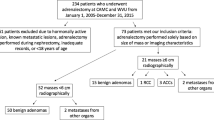Abstract
Background
Recent studies have shown that a minimum of approximately one-third of one normal adrenal gland is required for sufficient adrenocortical stress capacity. Correlation between intraoperative measurement, determination of remnant size by computed tomography (CT), and adrenocortical stress capacity has not been examined so far.
Methods
Twenty-two patients with familial pheochromocytoma (n = 13), sporadic pheochromocytoma (n = 3), and adrenocortical tumors (n = 6) who underwent unilateral or bilateral subtotal adrenalectomy (STAE, 28 adrenal remnants) were prospectively studied. Patients were examined in a multi-slice CT to determine residual adrenal tissue and by ACTH test 4 days and 3 months postoperatively.
Results
There was a slight significant correlation between intraoperative and CT calculated volumes (r = 0.77; p < 0.001). However, volumes assessed by CT were almost doubled compared with intraoperative determination (p < 0.001). Although recovery of adrenal function could be observed, no significant changes of remnant volumes could be detected within 3 months. In patients with familial pheochromocytoma, there was a significant correlation between residual adrenal volume and stimulated cortisol levels (P < 0.001). A distinct minimum of adrenal volume for intact adrenocortical stress capacity could not be exactly determined; however, in one patient with only 10% residual adrenal tissue intact stress capacity was found.
Conclusions
Residual adrenal tissue of approximately 10–15% offers intact stress capacity. However, an exact determination of the size of an adrenal remnant after STAE has limitations. CT gives larger volumes compared with intraoperative determination. For calculation of a volume–function correlation of residual adrenal tissue, in clinical practice, the determination of relative adrenal residual volume is acceptable.




Similar content being viewed by others
References
Lee JE, Curley SA, Gagel RF, et al. (1996) Cortical-sparing adrenalectomy for patients with bilateral pheochromocytoma. Surgery 120:1064–1070
Neumann HPH, Bender BU, Reincke M, et al. (1999) Adrenal-sparing surgery for pheochromocytoma. Br J Surg 86:94–97
Walz MK, Peitgen K, Neumann HP, et al. (2002) Endoscopic treatment of solitary, bilateral, multiple, and recurrent pheochromocytomas and paragangliomas. World J Surg 26:1005–1012
Brauckhoff M, Gimm O, Thanh PN, et al. (2003) Critical size of residual adrenal tissue and recovery from impaired early postoperative adrenocortical function after subtotal bilateral adrenalectomy. Surgery 134:1020–1027
Yip L, Lee JE, Shapiro SE, et al. (2004) Surgical management of hereditary pheochromocytoma. J Am Coll Surg 198:525–534
Walz MK, Peitgen K, Saller B, et al. (1998) Subtotal adrenalectomy by the posterior retroperitoneoscopic approach. World J Surg 22:621–626
Janetschek G, Lhotta K, Gasser R, et al. (1997) Adrenal-sparing laparoscopic surgery for aldosterone-producing adenoma. J Endourol 11:145–148
Sasagawa I, Suzuki H, Izumi T, et al. (2000) Posterior retroperitoneoscopic partial adrenalectomy using ultrasonic scalpel for aldosterone-producing adenoma. J Endourol 14:573–576
Brauckhoff M, Thanh PN, Gimm O, et al. (2003) Functional results after endoscopic subtotal cortical-sparing adrenalectomy. Surg Today 33:342–348
Brauckhoff M, Gimm O, Dralle H (2004) Preoperative and surgical therapy in sporadic and familial pheochromocytoma. Front Horm Res 31:121–144
Cope O, Raker JW (1955) Cushing’s disease. The surgical experience in the care of 46 cases. N Engl J Med 253:165–172
Kennedy AL, Montgomery DA, Welbourn RB (1978) Hypothalamic-pituitary-adrenal function of untreated longterm survivors following subtotal adrenalectomy for Cushing’s disease. Ir J Med Sci 147:420–424
Irvin GL 3rd, Fishman LM, Sher JA (1983) Familial pheochromocytoma. Surgery 94:938–940
van Heerden JA, Sizemore GW, Carney JA, et al. (1984) Surgical management of the adrenal glands in the multiple endocrine neoplasia type II syndrome. World J Surg 8:612–621
Edstrom E, Grondal S, Norstrom F, et al. (1999) Long term experience after subtotal adrenalectomy for multiple endocrine neoplasia type IIa. Eur J Surg 165:431–435
Walz MK (2004) Extent of adrenalectomy for adrenal neoplasm: cortical sparing (subtotal) versus total adrenalectomy. Surg Clin North Am 84:743–753
Günther G (1972) Mitoses, cell multiplication and cell displacement in the adrenal cortex. Histometric and autoradiographic studies following subtotal and unilateral epinephrectomy. Endokrinologie 60:356–378
Engeland WC, Ennen WB, Elayaperumal A, et al. (2005) Zone-specific cell proliferation during compensatory adrenal growth in rats. Am J Physiol Endocrinol Metab 288:E298–306
Brunn J, Block U, Ruf G, et al. (1981) Volumetric analysis of thyroid lobes by real-time ultrasound. Dtsch Med Wochenschr 106:1338–1340
Oelkers W (1996) Adrenal insufficiency. N Engl J Med 335:1206–1212
Herrick RC, Hayman LA, Taber KH, et al. (1997) Artifacts and pitfalls in MR imaging of the orbit: a clinical review. Radiographics 17:707–724
Gottschau M (1883) Struktur und embryonale Entwicklung der Nebennieren bei Säugetieren. Arch Anat Physiol (Leipzig) 9:412–458
Estivariz EF, Lowry PJ, Jackson S (1992) Control of adrenal growth. In: James VHT (ed) The adrenal gland. Raven Press, New York, p 43–70
Bicknell AB, Lomthaisong K, Woods RJ, et al. (2001) Characterization of a serine protease that cleaves pro-gamma-melanotropin at the adrenal to stimulate growth. Cell 105:903–912
Ulrich-Lai YM, Marek DJ, Engeland WC (2002) Capsaicin-sensitive adrenal sensory fibers participate in compensatory adrenal growth in rats. Am J Physiol Regul Integr Comp Physiol 283:R877–R884
Srougi M, Gittes RF (1978) Adrenal autotransplantation. Urol Surv 28:41–48
Srougi M, Gittes RF, Underwood RH (1980) Influence of exogenous glucocorticoids and ACTH on experimental adrenal autografts. Invest Urol 17:265–268
Author information
Authors and Affiliations
Corresponding author
Rights and permissions
About this article
Cite this article
Brauckhoff, M., Stock, K., Stock, S. et al. Limitations of Intraoperative Adrenal Remnant Volume Measurement in Patients Undergoing Subtotal Adrenalectomy. World J Surg 32, 863–872 (2008). https://doi.org/10.1007/s00268-007-9402-y
Published:
Issue Date:
DOI: https://doi.org/10.1007/s00268-007-9402-y




